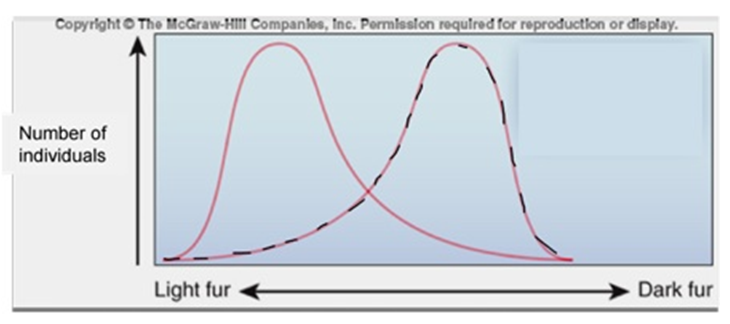What localization occurs for proteins that are normally nuclear when their nuclear localization signal is deleted and the protein is injected into the cytoplasm of cultured cells?
a. Nucleus
b. Cytoplasm
c. In a ring around the outside of the nuclear envelope
d. Extracellular
Ans: c. In a ring around the outside of the nuclear envelope
You might also like to view...
What type of natural selection are the population of voles going through?
A population of voles (very small mammals) live in a shady forest. The all of the voles are a light tan color, a dark brown coloration arises by a new mutation. The darker voles are harder for predators to see in the leaf litter, thus they are less susceptible to predation. After 10 generations the majority of voles in the population are the dark brown color. In the figure above the solid red line represents the number of light colored individuals before the mutation and the black dashed line represents the number of dark brown individuals after 10 generations.

A. Directional selection.
B. Stabilizing selection.
C. Diversifying selection (disruptive selection).
D. Balancing selection.
E. Negative frequency-dependent selection.
The gene (IGF1) that encodes a growth hormone has one allele (IGF1-A) that is found in small dogs but not in dogs that are very large. What does this suggest about body size of small dogs?
A. Body size depends on how much growth hormone is produced during early fetal development. B. Body size depends on whether or not the IGF1-A allele is present, if it is the dog grows very large, if it is not present the dog retains a small size. C. It suggests that small dogs are small because the IGF1-A allele is expressed, perhaps inhibiting the growth of the dog and the release of growth hormone. D. It suggests that small dogs have more growth hormone released during fetal development but none released after the birthing process. E. Body size depends on nutrition, not on genetics.
Treponema pallidum: genomic analysis of metabolism
What will be an ideal response?
Regardless of its shape, a given orbital may contain no more than:
A. 8 electrons. B. 4 electrons. C. 1 electron. D. 2 electrons.